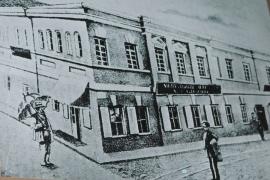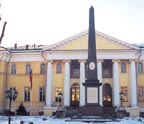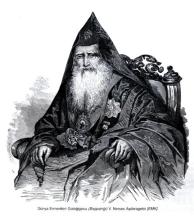
Armenian News Network / Groong
August 3, 2005
Travel Wire
By Ruth Bedevian
YEREVAN, ARMENIA
Where and how did Modern Armenian Literature and public education come about after centuries of feudal life?
This thought kept hovering over me as I continued my visits to Armenian authors' house museums in Armenia. Where did these authors go to school? Who were their teachers? In turn, who did these authors educate and what contributions did they make? With these queries, I share this cursory and modest extraction of what I have come to appreciate as a third generation Armenian-American.
With the captivity of King Leon de Lusignan in 1375, Cilician Armenia ceased to exist. Armenians lost political independence and power. Consequently, the extraordinary momentum of Armenian intellectual enlightenment which had flourished in the monasteries following Armenia's conversion to Christianity in 301 AD was badly shaken. Despite this wound and the adverse political situation from the 14th to the 18th centuries, Armenian education continued its concentration in the monasteries. During turbulent periods, the great monastic intellectuals fled from monastery to monastery and after finding a safe haven dedicated their time and energy to educate and prepare intellectuals. Beginning with the middle and later decades of the 18th century, parochial schools also began to function in large cities outside of Armenia. These schools were closely affiliated with local churches. Ultimately these schools yielded their place to institutions that were patterned after European models. Thus Armenian intellectual activity struggled in this dispersed fashion in places such as India, Italy, France, Georgia, Russia and elsewhere - wherever Armenians congregated for survival.
At the dawn of the 1800s, Armenians were under Persian, Ottoman or Russian rule, depending upon which part of their ancient soil they happened to be born. Into this climate Armenian youth strove for intellectual growth and not having a university of their own, left for foreign universities in St. Petersburg, Moscow, Berlin, Leipzig, Heidelberg, Paris, Geneva, Dorpat [now Tartu University in Estonia] - to name a few. Ah - but to enter these demanding universities who used the Russian, German or French languages of instruction, an entrant had to be very well prepared. The fertile ground for this preparation was laid primarily at six stellar institutions.

|
| Nersisian School |
Six important schools were established during the 1800s: the Aghababyan School in Astrakhan [Southern Russia]; The Lazaryan Academy in Moscow; the Nersisian School in Tiflis (now Tbilisi, Georgia); the Gevorgian Seminary in Etchmiadzin; and the Perperian and Kedronagan schools of Constantinople. These schools, with the exception of Gevorgian and Kedronagan, do not exist anymore, but their contributions to Armenian intellectual life are invaluable. Destiny drove them to arrive upon the Armenian scene at a most critical time - a time when the sustained absence of a free and independent homeland was threatening destruction to an ancient people. There were many other schools that emerged during the 1800s, but these six institutions of learning created an outstanding constellation, grooming generations of intelligentsia that led the common people into an enlightened age. They prepared a stateless people to reassure themselves; they fostered national pride and spirit in the common people as they were to enter the 20th century to face the blackest event in their history and thus, far greater dispersion.
THE AGHABABYAN SCHOOL - ESTABLISHED IN 1810
Astrakhan, a Russian city, located at the mouth of the Volga River where it enters the Caspian sea is a sizeable port. It is the shortest, most convenient route from Europe to Central and South Asia. It attracted many Armenians, especially from Iran. `According to available historical documents, an eight-fold increase in the Armenian population was recorded in Astrakhan alone around the middle of the 18th century, thus necessitating the establishment of a diocese in 1773 under the leadership of Archbishop Hovsep Arghoutian....According to records kept by Arghoutian, 3,500 Armenians lived in Astrakhan in 1782....where records indicate that more than 81 percent of Russia's import trade was in the hands of Armenian businessmen..'[1]
The natural course was for the Armenian community to set down roots with a church and school. The school was named after its founder Nikoghayos Aghababyan, who was a merchant born in Isfahan, Persia. Having moved to Russia, he asked the Russian government in 1804 for permission to create an Armenian school in Astrakhan, and was able to erect a building and invite teachers through the money of the wills of his brothers Hakob and Stepanos. At first there were only two levels of classes for children, while in 1839 it was given a third level of classes, so that the program in all would take 5-6 years to graduate. During its 107 year existence the number of students ranged from fifty to 150. In 1917 the school was closed permanently.
Haratune Alamdaryan (1796-1834) was born in Astrakhan and educated at the Aghababyan School. A married priest, he spent the first ten years of his married life in Moscow organizing the newly founded Lazaryan Institute. Following that major achievement he became the first director of the newly established Nersisian School in Tiflis (1824-1830). From a modest beginning, this alumnus designed the standard for two schools of great distinction.
THE LAZARYAN INSTITUTE - ESTABLISHED IN 1815

|
| Lazarian Inst. |
The school became a famous Armenian and Oriental Studies center. Because of the Lazaryan Institute's standards for distinction, generations of intellectual development grew. An intelligentsia was groomed that would lead the Armenian people into the 20th century. The brightest and best students from all of Russia attended Lazaryan. Its library housed 8000 books, and it published books in thirteen languages. In 1918 it was seized and closed by the Bolsheviks. Today the building is used as the Armenian Embassy in Moscow. There is a flicker of hope to re-open the school to serve the large number of Armenians who have emigrated from Armenia in the last decade. For a hundred years, Lazaryan's alumni nurtured Armenian writers, poets, political leaders, newspaper editors and educators. [2]
Hovhannes Hovhannesyan [1864-1929] is one extraordinary example. An advocate for Modern Armenian Literature, a poet and educator, he returned to his birthplace, Etchmiadzin, following graduation. He taught at Gevorgian Seminary all of his lifetime, influencing generations of gifted students.
Raphael Patkanian (1830-1892) [Pen name was Kamar Katiba], also an alumnus of Lazaryan, founded a short-lived periodical, Husis [The North]. His acerbic piece, `Complaint to Europe,' made history in which he denounced Europe for abandoning Western Armenia. [In 1878, Europe ignored the Armenians in the Treaty of San Stefano and the Congress of Berlin.] He was committed to social concerns and the condemnation of corruption and injustice. Through his songs, poems, text-books, he introduced a popular era for the common man's erudition.
NERSISIAN SCHOOL -ESTABLISHED IN 1825

|
| Nerses V Ashdaragetsi |
The Nersisian School's celebrated list of alumni presents a long list of accomplishments. The introduction of widespread public education to enlighten mass peasantry had its rudimentary beginnings with the Nersisian and Lazaryan schools because they prepared the teachers, educators, writers, activists for the later years of the century. One of the major pioneers of the Modern Armenian [Askharapar] Movement was Khatchatur Abovyan, one of the earliest alumni, who furthered his education at the University of Dorpat in Estonia. He became the champion of popular education and is credited with being the `Father of Modern Armenian.'
Another important alumnus who made his mark upon future generations was Stepan Nazarian (1812-1879). Considered a brilliant intellectual, he like Abovyan, also graduated from Dorpat in 1832, receiving his PH.D. later from the University of Kazan (Russia). He served on the faculty of Lazaryan until his demise in 1879 and through the influential periodical which he founded in Moscow, [Hiwsisapayl =The Northern Lights], he advanced the cause for Modern Armenian Literature.
Armenia's beloved poet/writer, Hovhannes Toumanyan, received his highest education at Nersisian. Out of necessity, he had to abandon further schooling to support his family when his father died, and therefore did not graduate.
Another alumnus, Perj Proshyan((1837-1907), made valuable contributions as an educator, novelist and translator. He also supported Armenian theater.
GEVORGIAN SEMINARY ESTABLISHED 1873-74
Gevorgian Seminary was named after Catholicos Gevorg IV of Constantinople (1866-1882)] and continues to nurture intellectuals. The Seminary celebrated its 130th anniversary in 2004. Among many alumni are four noteworthy students: Avetik Isahakyan (famed poet); Aksel Bakuntz [1899-1936] - a short story writer who was cut down in his youth during the Stalin purges; Derenik Demirjian [1877-1956] - an historical novelist known for his masterpiece, Vartanank, and writer of children's stories that are still popularly read in Armenia today; and Komitas Vartabed [1869-1935] -clergyman and gifted musicologist who revived and recorded Armenian folk music and whose contributions to the world of music in general are brilliantly manifold. One of their beloved teachers was Hovhannes Hovhannesyan, the Lazaryan alumnus mentioned previously.
Garegin Hovsepian (1867-1952) was a teacher at Gevorgian and chief librarian at Etchmiadzin's Matenadaran before his responsibilities grew greater in his ministry. He later served as Catholicos of the Great House of Cilicia from 1943 until his death. He participated at the battle of Sardarapat against the Turkish invaders (1918). Archives of his papers are stored at the Madenataran in Yerevan contain, among many other documents, letters related to the Armenian volunteers of WW I.
Mesrop Maksudian (1876-1917) was another student of Gevorgian Seminary who became a philologist and clergyman. After completing higher education in France, he returned to his alma mater and taught linguistics. Maksudian wrote poetry, translated and examined the ornamental letters in the miniatures of the Armenian manuscripts.
PERPERIAN SCHOOL IN CONSTANTINOPLE - FOUNDED IN 1876
Reteos Perberian (1850-1907), a prominent educator, poet and linguist, founded his own school which attained very high prestige where generations of Armenians and a host of prominent Armenian intellectuals were educated. It moved to Cairo, Egypt in 1924. Its 50 year history ended in 1934 with the closing of the school.
Madteos Zarifian (1894-1924) received his education at Perperian. An outstanding athlete, he was training to compete in the World Olympic games. His hopes ended abruptly when at the age of 27 he was diagnosed with Tuberculosis. He turned to poetry to cope, and although not a sophisticated poet as was Vahan Terian, Avetik Isahakyan or Hovhannes Toumanian (who were his contemporaries), he is revered by literary critics as having made a genuine contribution in his short life.
KEDRONAKAN IN CONSTANTINOPLE - FOUNDED IN 1886
This school was founded under the initiative of Patriarch Nerses Varzhabedian. Minas Tcheraz was president for the first three years. Abp. Maghakia Ormanian, Bishop Karekin Srvandziantz, Hagop Baronian, Eghia Demirjibashian, Tovma Terzian, and many other prominent people served as teachers in the early years. Archbishop Izmirlian and Bishop Eghishe Turian taught in later years.
Misak Metzarents (1886-1908) was not able to finish his schooling at the Kedronakan due to his declining health and at the very early age of 22 he died. Notwithstanding, he left a rich legacy of poetry and is considered one of the significant forerunners to the great writers of Modern Armenian Literature.
T'lkatintsi [Born Hovhannes Haroutunian c1860-] was the principal of Kedronagan school in the years prior to the Genocide. This institution was not a boarding school. It offered a higher education to needy students at a high level not often available in the provinces. History credits T'klatintsi with having made the Kedronakan the finest school in the Armenian provinces. In addition to being an educator, he wrote poems, plays and short novels. He was murdered outside of his native Kharpert during the slaughter of intellectuals in 1915.
Another alumnus of Kedronakan, Arshak Chobanian, made Paris his home from 1895 until his demise. From abroad he launched his first periodical, `Anahit' [1898] and later `Varatznund,' [1917-21]. A poet, playwright, journalist and translator, he spread Armenian culture in the Diaspora, especially with translations into French. He made his mark as a most distinguished literary critic and is considered a pioneer in literary criticism for Western Armenian literature.
A WORD OF ACCLAIM FOR THE MEKHITARIST FATHERS
It is fair to speak of the Mekhitarists in the context of their contribution to the Modern Armenian Literature Movement and their efforts to educate the common people. This Armenian Catholic Order accomplished significant ground work in the 1700s, establishing itself in Venice, Italy in 1715. It rendered invaluable service to the common people through the establishment of schools. Abbot Mekhitar, himself the founder of the St. Lazar Congregation, had compiled a grammar of Modern Armenian speech. With distribution of books, pamphlets and periodicals, the Mekhitarists early on helped to popularize national and foreign works, which were, until then, only available to an elite and highly educated group of clergymen. They were successful in reaching populations of Armenians. The Mekhitarist Congregation of Vienna, which had its beginning in 1774, produced many eminent scholars, such as S. Tornian, H. Katerjian, M. Karakashian, G. Menevishian, G. Sibilian, S. Dervishian, H. Dashian, G. Hovanian, G. Kalemkiarian, and N. Akinian. Archbishop Arsen Aydenian (1825-1902), mastered ten languages, ancient and modern. Western scholars knew his work and admired him and his culture. His great work, A Critical Grammar of the Modern Armenian Language is a masterpiece on Armenian philology.[4]
Grigor Ardzrouni (1845-1892) studied literature at St. Lazar, Venice. His name is known for launching `Mshak,' in Tiflis. It was a weekly publication which grew successfully into a daily paper. Despite setbacks, `Mshak' survived, even for ample time following Ardzrouni's death. It was a progressive newspaper, its aim being the salvation of the new generation and the awakening of national consciousness. It ceased to appear in 1920. Ardzrouni was a mentor to a young Raffi, who worked as a journalist on the paper. Raffi later earned fame with many of his novels, Khent [The Fool], being a prominent one. He worked hard to advance Modern Armenian Literature among the peasantry.
Taking his friend's counsel, Gosdan Zarian who had almost lost his native Armenian because he had been sent to boarding school in France at an early age, studied with the Mekhitarists at San Lazarro from 1910 - 1913. By 1914 Zarian had mastered both classical and modern Armenian and re-located to Constantinople. He collaborated with Daniel Varoujan, Hagop Oshagan, Kegham Parseghian and founded the literary periodical, `Mehian.'
Mkrtich Peshisktashlian received his education at the Mekhitarist school in the district of Pera where he was born. He composed poems and wrote drama in both Classical and Modern Armenian. He is remembered for founding and acting in the Armenian Theater of Constantinople.
Ghevond Alishan(1820 - 1901), a Mekhitarist student in Venice, became a celibate priest. From 1850 to 1880 he became a most influential poet and historian. His students, including Thomas Terzian, Meguerdich, Ajemian, Serabion Teghlian (and, much later, Arpiar Arpiarian) were among those responsible for the Armenian Renaissance. Alishan translated Byron's poems into Armenian, In 1852 in London he translated a volume of American poetry.
This constellation of significant schools that spanned thousands of miles across the map from Tiflis to Astrakhan to Moscow to Constantinople to Italy ushered the Armenian people into the 20th century. The noble deeds of hundreds of alumni validate the great impact of these schools. Collectively, these students and their classmates [too numerous to list here] bequeathed a legacy of literature and leadership. They set an example of academic excellence and integrity. They demonstrated respect for universal humanity with their interest in international literature and diligent translations of foreign writers. Even more, while studying the foreigners' literature and using the foreigners' language, they cultivated and sustained an abiding love for their own language, literature and nation. And where does such love germinate, but under the protective wing of the home and school. `Train up a child in the way he should go, and when he is old he will not depart from it.' Proverbs 22:6
Footnotes:
Sources:
-- Ruth Bedevian continues her visits to Armenian authors' House Museums around Armenia. Her articles in this series are at: http://www.groong.org/orig/armeniahousemuseums.html
|
Redistribution of Groong articles, such as this one, to any other
media, including but not limited to other mailing lists and Usenet
bulletin boards, is strictly prohibited without prior written
consent from Groong's Administrator. � Copyright 2005 Armenian News Network/Groong. All Rights Reserved. |
|---|